通信英语口语朗读题型
- 格式:doc
- 大小:32.50 KB
- 文档页数:10

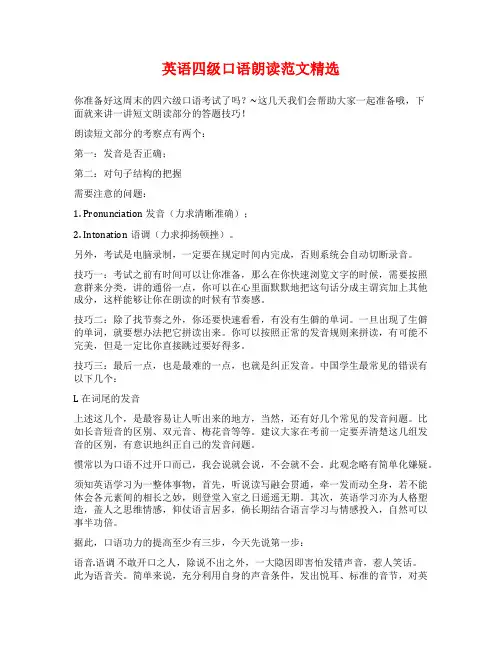
英语四级口语朗读范文精选你准备好这周末的四六级口语考试了吗?~这几天我们会帮助大家一起准备哦,下面就来讲一讲短文朗读部分的答题技巧!朗读短文部分的考察点有两个:第一:发音是否正确;第二:对句子结构的把握需要注意的问题:1. Pronunciation 发音(力求清晰准确);2. Intonation语调(力求抑扬顿挫)。
另外,考试是电脑录制,一定要在规定时间内完成,否则系统会自动切断录音。
技巧一:考试之前有时间可以让你准备,那么在你快速浏览文字的时候,需要按照意群来分类,讲的通俗一点,你可以在心里面默默地把这句话分成主谓宾加上其他成分,这样能够让你在朗读的时候有节奏感。
技巧二:除了找节奏之外,你还要快速看看,有没有生僻的单词。
一旦出现了生僻的单词,就要想办法把它拼读出来。
你可以按照正常的发音规则来拼读,有可能不完美,但是一定比你直接跳过要好得多。
技巧三:最后一点,也是最难的一点,也就是纠正发音。
中国学生最常见的错误有以下几个:L 在词尾的发音上述这几个,是最容易让人听出来的地方,当然,还有好几个常见的发音问题。
比如长音短音的区别、双元音、梅花音等等。
建议大家在考前一定要弄清楚这几组发音的区别,有意识地纠正自己的发音问题。
惯常以为口语不过开口而已,我会说就会说,不会就不会。
此观念略有简单化嫌疑。
须知英语学习为一整体事物,首先,听说读写融会贯通,牵一发而动全身,若不能体会各元素间的相长之妙,则登堂入室之日遥遥无期。
其次,英语学习亦为人格塑造,盖人之思维情感,仰仗语言居多,倘长期结合语言学习与情感投入,自然可以事半功倍。
据此,口语功力的提高至少有三步,今天先说第一步:语音.语调不敢开口之人,除说不出之外,一大隐因即害怕发错声音,惹人笑话。
此为语音关。
简单来说,充分利用自身的声音条件,发出悦耳、标准的音节,对英语学习可谓作用大矣。
试想,自己发出来的声音连自己都不欣赏,都不能使自己愉悦,那哪里还有自信去征服别人的耳朵?故而,建立口语的基础和自信,首先从语音做起。

英语口语人机对话考试题型1. Multiple choice questions: The student will be given a question and four possible answers. They must choose the correct answer. Example:- Assistant: Which of the following is NOT a country in Europe? - Student: A. France B. Japan C. Italy D. Germany- Assistant: B. Japan is the correct answer.2. Fill in the blank: The student is given a sentence with a missing word or phrase. They must fill in the blank with the correct word or phrase.Example:- Assistant: My friend is a ___________ player and he plays for the national team.- Student: professional- Assistant: That's correct. My friend is a professional player and he plays for the national team.3. Sentence completion: The student will be given an incomplete sentence and must complete it.Example:- Assistant: I am really good at swimming, _________.- Student: but I am not very good at running.- Assistant: That's correct. I am really good at swimming, but I amnot very good at running.4. Role-play: The student will be given a scenario and must have a conversation with the assistant, acting out the given roles. Example:- Assistant: You are at a restaurant and want to order food. Start a conversation with the waiter.- Student: Waiter, may I see the menu, please?- Assistant (acting as the waiter): Of course, here is the menu. What would you like to order?- Student: I think I'll have the pasta with tomato sauce, please.- Assistant (acting as the waiter): Excellent choice. Anything else? - Student: No, that's all. Thank you.- Assistant (acting as the waiter): You're welcome. Your order will be ready soon.5. Information exchange: The student will be given a topic or question and must have a conversation with the assistant to exchange information.Example:- Assistant: Discuss the advantages and disadvantages of using public transportation.- Student: Well, one advantage of public transportation is that it is usually cheaper than owning and maintaining a car. On the other hand, it can often be crowded and delayed, especially during peak hours. Additionally, public transportation may not always beconvenient if the routes do not cover all areas.- Assistant: That's a good point. Are there any other advantages or disadvantages you can think of?- Student: Another disadvantage of using public transportation is that you have to follow the schedule and cannot be as flexible with your travel plans. However, it does help reduce traffic congestion and air pollution.- Assistant: I agree. Thank you for sharing your insights.。
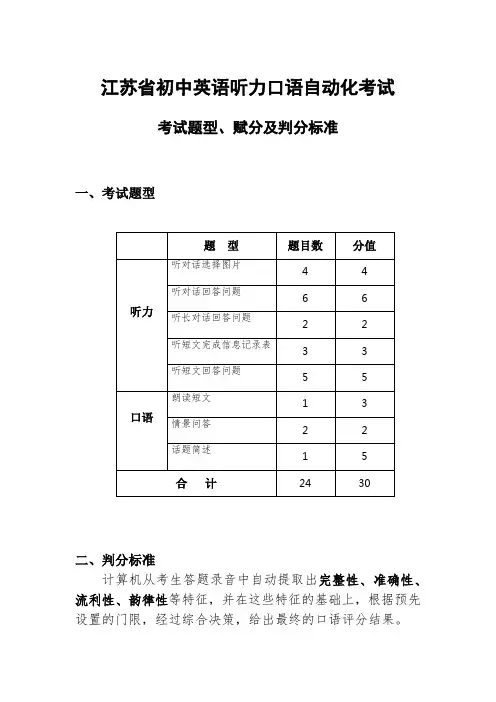
江苏省初中英语听力口语自动化考试
考试题型、赋分及判分标准
一、考试题型
二、判分标准
计算机从考生答题录音中自动提取出完整性、准确性、流利性、韵律性等特征,并在这些特征的基础上,根据预先设置的门限,经过综合决策,给出最终的口语评分结果。
门限设置
完整性
●朗读题目:能否顺利读完全文,顺利读完的比例;
●话题简述题:能否完整表达题目的语意,清楚表
达的语意比例;
●完整性特征是评分的起评基本特征(70%);
准确性
●单词级评估,单词发音的元音、辅音、重音准确
性等(20%);
流利性
●句子级评估,主要包括语速、停顿、插入(重复、
修正)、连贯(连读、失去爆破、同化)等(5%); 韵律性
●句子、段落级评估,主要包括意群停顿(节奏)、
重读弱读、语气语调等(5%)。

青岛中考英语人机对话题型一.交际问答此题读一遍依据所听到的句子,说出相应的答语。
(共5小题,每小题1分,共5分)提示音停顿1秒1.How do you usually go to school?(停顿10秒录音)2.What’s the date today?(停顿10秒录音)3.How often do you watch TV?(停顿10秒录音)4.What’s your favorite color?(停顿10秒录音)5.When were you born?(停顿10秒录音)二.朗读短文此文只看不听朗读下面短文。
请在听到“叮咚”的提示音后,朗读该短文,你有110秒时间来完成录音。
(大约170词的文章)The Smiths are at the airport. They are saying goodbye to their son Mark and his family. Mark and his family are going to live in Beijing. They are going to stay with his wife’s relatives. Mark will work in the family’s restaurant. Alice, his wife, will take any job she can find. The children will begin school in September.The Smiths are both happy and sad. They are happy because they know their son and his family will have a good life in their new home. However, they are sad because they are going to be lonely.Their house will be quiet and empty, they’ll have to spend holidays by themselves, and they won’t see their grandchildren grow up.Some day the Smiths will visit Beijing, or perhaps they’ll even move there. But until then, they are going to miss their family very much. As you can imagine, it’s very difficult for them to say goodbye.等待90秒……(提示音)停顿110秒录音……三.话题表达依据所给的话题,进行口头表达。
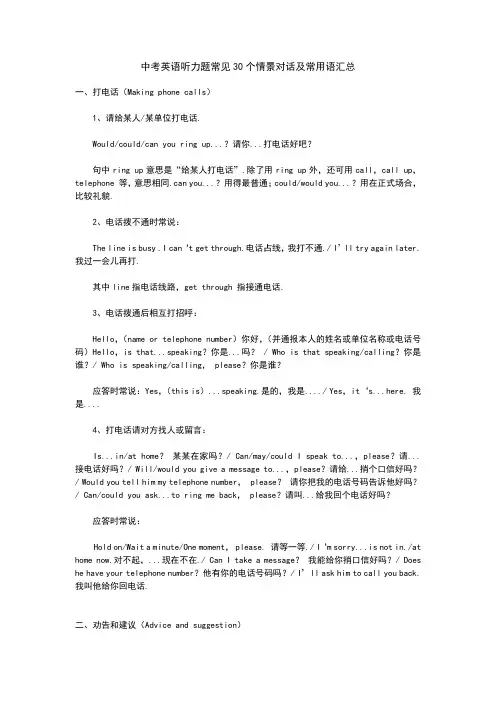


【英语一级口语试题】pets1口语真题12级大学英语4口语试题云南师范大学文理学院20XX年-20XX年学年下学期20XX年级大学英语(4)口语期末考试试题I. Read the following paragraphs in book III. (30%)(主要考核学生是否朗读流畅,发音准确,语音语调规范。
)Unit 1: paragraph 11Unit 2: paragraph 1 and 2Unit 3: paragraph 7Unit 4: paragraph 22Unit 5: paragraph 22 and 23II. Create dialogues according to the following questions or situations. (30%)(主要考核学生是否内容充实,语言基本流畅准确地表达对话内容)1. Talk with your partner about some heroes that impress you a lot. 2. Have you ever acted as a hero or heard of a story of a hero? Please share it with your partner?3. Discuss with your partner what skills are essential for effective communication.4 Discuss with your partner whether it is necessary to use body language when communicating with others? Why or why not?5. Talk with your partner about how to deal with stress.6. Talk with your partner about the symptoms of stress.7. Talk with your partner about culture shock.8.Talk with your partners about the risks of online shopping.III. Talk on the given topics (40%)(主要考察学生是否能就特定话题展开有一定深度的阐述)1. Can a common man be a hero? Why or why not?2. A friend in need is a friend indeed. Explain the significance of having a friend.3. What skills are essential for effective communication?4. Have you ever had misunderstanding when communicating with others? How did you deal with it?5. Did you feel anxious? Talk about it.6. Do you want to study apoad? Why or why not?7. Do you like doing shopping online? If yes, show us the advantages of online shopping.注意事项:口语成绩最高分不超过95分,优秀率不超过10%。

高考英语口试题目及答案一、自我介绍(Self-introduction)1. 请用英语简单介绍你自己。
- 答案:My name is Li Hua. I am 18 years old and currently a senior high school student.二、日常对话(Daily Conversation)2. 你通常如何度过周末?- 答案:I usually spend my weekends reading books, watching movies, and hanging out with friends.3. 你最喜欢的季节是什么?为什么?- 答案:My favorite season is autumn because the weather is cool and the leaves are beautiful.三、话题讨论(Topic Discussion)4. 你认为学习英语的重要性是什么?- 答案:I believe learning English is important because it is a global language and can help us communicate with people from different countries.5. 描述一下你理想中的工作。
- 答案:My ideal job would be as a software engineer because I am passionate about technology and enjoy problem-solving.四、情景模拟(Situational Simulation)6. 假设你在一家餐厅,服务员问你需要什么帮助。
- 答案:Excuse me, could you please recommend a popular dish? And I would like to have a glass of water.7. 你正在和一个外国朋友讨论中国传统节日,你会如何介绍春节?- 答案:The Spring Festival, also known as Chinese New Year, is the most important traditional festival in China. It marks the beginning of the lunar new year and is a time for family reunions and celebrations.五、观点阐述(Opinion Expression)8. 你如何看待环境保护?- 答案:I think environmental protection is crucial for our planet. We should reduce pollution, recycle more, and protect natural resources.9. 你认为科技对日常生活的影响是什么?- 答案:I believe technology has a significant impact on our daily lives. It makes communication easier, provides access to information, and improves efficiency.六、问题解决(Problem Solving)10. 如果你在学习中遇到难题,你通常如何解决?- 答案:When I encounter difficulties in my studies, I usually seek help from my teachers or classmates, and I also research the topic online to gain a deeper understanding.11. 描述一下你如何解决与朋友的误会。
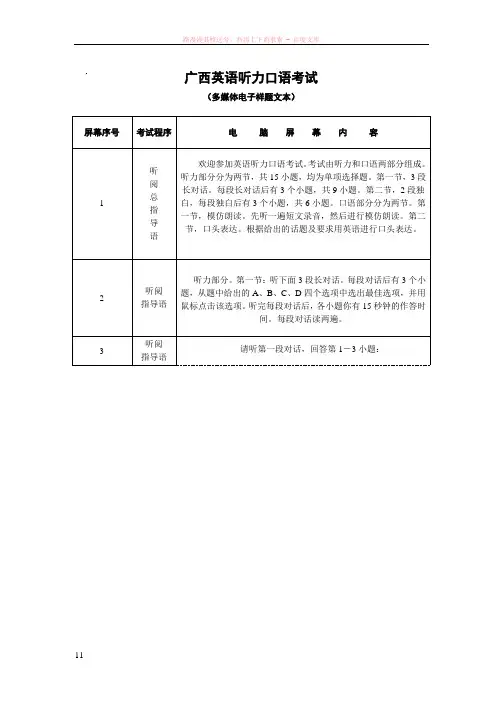
广西英语听力口语考试(多媒体电子样题文本)屏幕序号考试程序电脑屏幕内容1 听阅总指导语欢迎参加英语听力口语考试。
考试由听力和口语两部分组成。
听力部分分为两节,共15小题,均为单项选择题。
第一节,3段长对话。
每段长对话后有3个小题,共9小题。
第二节,2段独白,每段独白后有3个小题,共6小题。
口语部分分为两节。
第一节,模仿朗读。
先听一遍短文录音,然后进行模仿朗读。
第二节,口头表达。
根据给出的话题及要求用英语进行口头表达。
2听阅指导语听力部分。
第一节:听下面3段长对话。
每段对话后有3个小题,从题中给出的A、B、C、D四个选项中选出最佳选项,并用鼠标点击该选项。
听完每段对话后,各小题你有15秒钟的作答时间。
每段对话读两遍。
3听阅指导语请听第一段对话,回答第1-3小题:4 听对话(考试时只显示上面图片,下段对话文字不显示)W: Hello, Luxair.M: Hello, I’d like to know the times of Sunday flights, please,er…from Luxemburg to Paris.W: From Luxemburg to Paris on Sundays?M: Yes, please.W: Yes, well, at the moment we have two flights a day at weekends. And, er…you may care to know that we have four a day at weekdays.M: Mmm.W: Now, the first flight leaves at 7:40 a.m. and arrives at 8:40 a.m. That’s flight number LG 201. And the second one, the evening flight, leaves at 6:45 p.m. and arrives at 7:45 p.m. The flight number is LG203.M: Mmm…Thanks very much. And, erm…what is the airport ofarrival, please?W: Well. Er…all arrivals are at Poissy Charles de Gaulle in Paris.M: Thank you very much.W: Not at all.M: Bye.W: Bye.5 听阅问题1.How many flights are there from Luxemburg to Paris on Sundays?6 考生作答1.How many flights are there from Luxemburg to Paris on Sundays?□A. 2.□ B. 3.□ C. 4.□D. 5.倒计时:15s7 听阅问题2. How long will the flight take from Luxemburg to Paris?8 考生作答2. How long will the flight take from Luxemburg to Paris?□A. One hour.□B. Two hours.□ C. Three hours.□D. Four hours.倒计时:15s9 听问题3. Which flight is at 7:40 on Sunday morning from Luxemburg toParis?10 考生作答3. Which flight is at 7:40 on Sunday morning from Luxemburg toParis?□A. Flight LG 204.□ B. Flight LG 203.□ C. Flight LG 202.□D. Flight LG 201.倒计时:15s11听阅指导语请听下面一段对话,回答第4—6小题:12 听对话(考试时只显示上面图片,下段对话文字不显示)M: Can you tell me something about your first job?W: Well, yes. It was with a large international company. They have a trainee programme for people from university and, well, that was my first job, trainee marketing manager.M: What exactly did you do?W: Well, the programme lasted eighteen months. During that time I worked in different departments – in personnel, purchasing,marketing and such things. I also went out with the salesrepresentatives to visit customers.M: Did you enjoy it?W: Yes, I did. I didn’t really know what I wanted to do when I left university, so it was good to see what the different departments did. Itwas really practical.M: It sounds interesting.W: Yes, it was. But it was very badly paid. I did the same work as other people. I think a lot of the trainees feel they are a cheap sourceof labour.M: Would you do it again?W: Sure. I learnt a lot. And found out where I really wanted to work.13 听阅问题 4. What are the speakers talking about?14 考生作答4. What are the speakers talking about?□A. The woman’s company.□ B. The woman’s school life.□ C. The woman’s manager.□D. The woman’s first job.倒计时:15s15 听阅问题5. What did the woman do after she left university?16 考生作答5. What did the woman do after she left university?□A. She worked for a marketing program.□ B. She worked in a large company as a worker.□ C. She worked as a trainee marketing manager.□D. She worked in different departments as a saleswoman.倒计时:15s17 听阅问题6. Why did she enjoy her first job?18 考生作答6. Why did she enjoy her first job?□A. Because it was exciting.□ B. Because it was really practical.□ C. Because she couldn’t find another job then. □D. Because it was a large international company.倒计时:15s19听阅指导语请听下面一段对话,回答第7-9小题:20 听对话(考试时只显示上面图片,下段对话文字不显示)Woman: Hey Jack. You look tired. What's going on?Man: It's finals week and I have been up all night studying.Woman: How many exams do you have left?Man: Three more to go?Woman: Have you been keeping up, or are you crammingeverything?Man: If I was keeping up, I wouldn't need to stay up all night.Woman: Ha ha ha. Looks like you are in for a tough week. Man: Tell me about it. How about you? What have you been up to?Woman: I finished my last final this morning.Man: So you're completely done?Woman: No. I have one more report that is due this Friday. I haven't started it yet, but it shouldn't be too tough. If you need help with your chemistry class, I can help you over the weekend.Man: That would be great.Woman: Let's get together Saturday around lunch time.Man: You don't know how much this means to me. Thanks.Woman: Don't mention it. I'll see you on Saturday.21 听阅问题7. Why is Jack so tired?22 考生作答7. Why is Jack so tired?□A. He was up all night drinking at a party.□ B. He was up all night studying.□ C. He got sick and is feeling tired all the time. □D. He just finished his last final this morning.倒计时:15s23 听阅问题8. What does ‘cramming’ mean in this dialog?24 考生作答8. What does ‘cramming’ mean in this dialog?□A. To drink as much as possible.□ B. To pack things using one small bag.□ C. To do last minute studying.□D. To have muscle pain from running too much.倒计时:15s25 听阅问题9. Why are they going to meet on Saturday?26 考生作答9. Why are they going to meet on Saturday?□A. Because the woman will help the man in Biology. □ B. Because the man will help the woman in Chemistry.□ C. To share notes in the history class.□D. To study together for the exams.倒计时:15s27听阅指导语第二节:听下面2段独白。
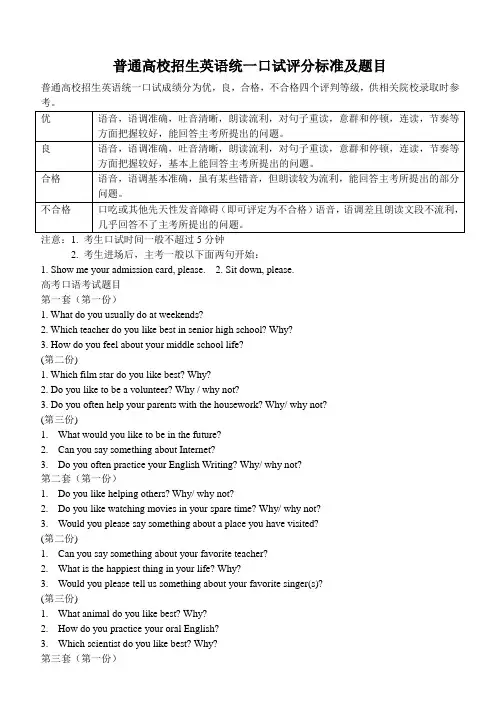
普通高校招生英语统一口试评分标准及题目普通高校招生英语统一口试成绩分为优,良,合格,不合格四个评判等级,供相关院校录取时参注意:1. 考生口试时间一般不超过5分钟2. 考生进场后,主考一般以下面两句开始:1. Show me your admission card, please.2. Sit down, please.高考口语考试题目第一套(第一份)1. What do you usually do at weekends?2. Which teacher do you like best in senior high school? Why?3. How do you feel about your middle school life?(第二份)1. Which film star do you like best? Why?2. Do you like to be a volunteer? Why / why not?3. Do you often help your parents with the housework? Why/ why not?(第三份)1.What would you like to be in the future?2.Can you say something about Internet?3.Do you often practice your English Writing? Why/ why not?第二套(第一份)1.Do you like helping others? Why/ why not?2.Do you like watching movies in your spare time? Why/ why not?3.Would you please say something about a place you have visited?(第二份)1.Can you say something about your favorite teacher?2.What is the happiest thing in your life? Why?3.Would you please tell us something about your favorite singer(s)?(第三份)1.What animal do you like best? Why?2.How do you practice your oral English?3.Which scientist do you like best? Why?第三套(第一份)1.How do you spend your Spring Festival?2.Can you say something about the people in your hometown?3.Do you like reading English novel? Why/ why not?(第二份)1.Which do you like best, Chinese food or western food? Why?2.How do you like to celebrate your birthday?3.Can you tell us something about your hobby?(第三份)1.What kind of school activities do you like best? Why?2.Do you like watching TV during the summer vacation? Why?3.Which place do you like to travel most? Why?第四套(第一份)1.How do you spend your summer holidays?2.Can you say something about your school life?3.What birthday present will you give to the members of your family? Why? (第二份)1.What’s your favourite TV programme?2.Can you say something about your learning habits?3.Can you tell us something about one of members in your family?(第三份)1.Can you say something about one of your classmates?2.Which university do you prefer to study? Why?3.Do you like English? Why or why not?第五套(第一份)1.What’s the date today?2.Can you say something about your senior school?3.What birthday present will you prefer to have? Why?(第二份)1.What do you usually do in your spare time?2.Do you like reading novels? Why/why not?3.Who is your favorite English teacher? Why?(第三份)1.What kind of books interests you most?Why?2.Do you like your English class? Why/ why not?3.Do you like to study in a university in our province? Why/ why not?。
英语听说练习题目English Listening and Speaking Practice ExercisesExercise 1: Listening ComprehensionObjective: To understand the main idea and details of a conversation or a speech.Instructions:1. Listen to the recording once to grasp the general idea.2. Listen again and take notes on the key points discussed.3. Answer the following questions:- What is the main topic of the conversation?- Who are the speakers?- What are the key points discussed?- What is the conclusion or the outcome of the conversation?Exercise 2: Pronunciation PracticeObjective: To improve pronunciation of words and phrases in English.Instructions:1. Read the list of words and phrases provided below.2. Listen to the audio pronunciation of each word and phrase.3. Repeat after the audio, focusing on the correct stress and intonation.4. Record your own pronunciation and compare it with the audio.Word List:- Environment- Opportunity- Pronunciation- International- ConversationPhrase List:- How are you doing?- I couldn't agree more.- That's a great idea!- Let's get started.- What's the weather like today?Exercise 3: Role-Play ScenarioObjective: To practice conversational English in a specific context.Scenario: You are at a restaurant, ordering food with a friend.Instructions:1. Prepare by reading through the menu.2. Take turns playing the roles of the customer and the waiter.3. Use polite expressions and ask for recommendations.4. Practice using vocabulary related to food and dining.Sample Dialogue:- Customer: Good evening, could you recommend a dish?- Waiter: Sure, our signature dish is the grilled salmon with a side of vegetables.- Customer: That sounds delicious. I'll have that, please.Exercise 4: Debate PracticeObjective: To develop the ability to express and defend opinions in English.Instructions:1. Choose a topic for debate, such as "The impact of social media on society."2. Divide into two teams, with one supporting the positive aspects and the other the negative aspects.3. Each team member should prepare arguments and counterarguments.4. Conduct the debate, ensuring each side gets an equal opportunity to speak.Exercise 5: StorytellingObjective: To enhance narrative skills and creativity in English.Instructions:1. Choose a theme for your story, such as "A day in the life of a superhero."2. Write a brief outline of the story, including thebeginning, middle, and end.3. Practice telling the story out loud, using descriptive language and varied intonation.4. Record your storytelling and listen to it to identify areas for improvement.Exercise 6: Interview SimulationObjective: To practice English in a formal interview setting.Instructions:1. Prepare a list of potential interview questions, such as "Tell me about yourself."2. Role-play an interview, with one person being the interviewer and the other the interviewee.3. Use appropriate language and maintain eye contact.4. After the interview, provide feedback on language use and body language.Exercise 7: News ReportObjective: To understand and retell news stories in English.Instructions:1. Listen to a news report from a reliable source.2. Take notes on the key points of the story.3. Summarize the news report in your own words.4. Discuss the implications or reactions to the news story with a partner.Remember, practice makes perfect. Regularly engage in theseexercises to improve your English listening and speaking skills.。
北京2024中考英语听力口语题型及分值1. 嘿,你知道吗?北京2024中考英语听力口语可太重要啦!就像一场超级重要的音乐会,每个音符(题型)都有它的价值(分值)呢。
比如说听句子选图片这种题型,就像在一堆五颜六色的拼图里找到正确的那一块,分值可能在1 - 2分左右。
2. 哇塞,还有听短文回答问题的题型哦。
这就好比是有人给你讲了一个故事,然后你得回答关于这个故事的各种小秘密。
这部分分值估计能占到3 - 5分呢,可不能小瞧。
3. 口语部分也超有趣。
有那种朗读短文的题型,就像是你变成了一个小小播音员。
你读得好不好,流利不流利,那都是有分的,大概2 - 3分的样子。
这就跟唱歌要唱准每个音一样重要。
4. 再说说看图片描述的题型吧。
这就像是你在给小伙伴介绍你看到的一幅超级有趣的画。
你得把画里的东西说得清清楚楚,这部分分值可能在3 - 4分呢。
5. 你想象一下,问答环节就像是一场小小的辩论。
考官问你问题,你得快速又准确地回答。
这分值可能有4 - 6分呢。
这就像在球场上,别人给你传球,你得稳稳接住并投进篮筐。
6. 听力里的听长对话选答案题型呀,就像在听两个好朋友聊天,然后找出他们聊天里隐藏的小答案。
这部分分值说不定在2 - 4分之间呢。
7. 口语中的话题简述题型可有点挑战性哦。
就像是你要在短时间内把一个故事或者观点讲得完整又精彩。
这分值大概在5 - 8分,就像跑一场很有难度的短跑比赛。
8. 听力中的听句子判断对错题型,就像在玩一个对错小游戏。
听到句子,你得马上判断是对是错。
这分值可能在1 - 3分,就像在玩猜硬币正反面的游戏,得很小心呢。
9. 口语里的情景对话题型超酷的。
就像是你在舞台上和小伙伴演一出小短剧。
你得根据情景做出合适的回应,这分值也许在4 - 7分。
10. 听短文填空题型有点像在寻宝。
短文里有些小宝藏(单词)被挖空了,你要把它们找出来填进去。
这分值大概在3 - 5分。
11. 口语中的口头作文题型呀,这可是个大考验。
英语口语人机对话考试题型英口语人机对话考试可以采用多种题型,以下列举几种常见的:1. 情景模拟对话:机器人模拟一个特定的情景,考生需要与机器人进行对话,如在餐厅点餐、询问路线、购物等。
2. 角色扮演对话:机器人扮演一个角色,考生需要与机器人进行角色扮演对话,如面试、讨论问题、解决纠纷等。
3. 讨论话题对话:机器人给出一个话题,考生需要与机器人进行讨论,如环保、旅游、教育等。
4. 情感表达对话:机器人表达特定的情感,考生需要理解并回应,如机器人说自己感到快乐、伤心等,考生需要适当回应。
5. 面试问答对话:机器人担任面试官角色,提出问题,考生需要回答问题,并展示自己的能力和素质。
这些题型旨在测试考生的口语交际能力、理解能力、表达能力和思维灵活性。
通过与机器人进行对话,考察考生在真实情境下的口语应用能力。
具体的题型和难度可能根据考试的级别和目的而有所不同。
当然,我可以给你举几个例子:1. 情景模拟对话:机器人:Welcome to the restaurant. How may I help you?考生:I'd like a table for two, please.机器人:Certainly. Follow me, please.2. 角色扮演对话:机器人:You are applying for a job as a salesperson. I am the interviewer. Please introduce yourself and explain why you are interested in this position.考生:Hello, my name is John. I have a passion for sales and enjoy interacting with people. I believe my strong communication skills and previous sales experience make me a good fit for this position.3. 讨论话题对话:机器人:Let's discuss the impact of social media on society. What are your thoughts on this topic?考生:I believe social media has both positive and negative impacts on society. On one hand, it connects people from all over the world and allows for easy communication. On the other hand, it can also lead to privacy issues and increased levels of online bullying.4. 情感表达对话:机器人:I'm feeling a little down today. It's been a rough week.考生:I'm sorry to hear that. Is there anything specific that's been bothering you?5. 面试问答对话:机器人:Tell me about a time when you had to work under pressure and how you handled it.考生:In my previous job, there was a tight deadline for a project.I prioritized tasks, communicated effectively with my team, and managed my time efficiently to ensure we met the deadline successfully.这些例子展示了不同类型的口语人机对话考试题型,涵盖了不同的场景和题材,考察了考生在不同情境下的口语表达能力。
1 / 10 GMDSS通信英语朗读题 1.Mayday Mayday Mayday This is motor-vessel Noble Prince Mayday Noble Prince One seven nine degrees true, three miles off Stone Point I have struck a submerged object, taking in water fast, engine damaged. I can not keep afloat more than three hours, crew thirty. Chief engineer and two ratings seriously injured, I need assistance and rescue. I am keeping continuous watch on two one eight two KHZ. This is motor vessel Noble Prince. Over. Questions: 1) What happened to Noble Prince? 2) What is the position of the distress vessel? 3) How long can the vessel keep afloat'? 4) How many persons were seriously injured? 5) On what frequency is she keeping continuous watch? Answers to the questions above: 1) She has struck a submerged object, taking in water fast, engine damaged. 2) One seven nine degrees true, three miles off Stone Point. 3) Less than three hours. 4) Three persons were seriously injured. 2 / 10
5) 2182 KHZ. 2. Mayday-Relay Mayday-Relay Mayday-Relay All ships. This is Barin Radio. Following received from motor vessel "Selin" There is a collision between two motor vessels in position forty-two fourteen degrees' north, sixteen seventeen degrees east. After a few minutes one ship tank and fourteen persons were lost. Some ships and helicopters are searching now. Ships in vicinity please keep sharp lookout. Mayday-relay. This is Barin Radio. Questions: 1) What happened in position 42˚14'N, 16˚17'E? 2) Has anything serious happened to either of the ships? If m, what is it? 3) Are there any search and rescue operations in the distress area? 4) What are ships in vicinity advised to do? 5) Who relays the Mayday message? Answers to the questions above: 1 ) There is a collision between two motor vessels in position forty-two fourteen degrees north, sixteen seventeen degrees east. 2) Yes. One ship sank and fourteen persons were lost. 3) Yes. ,Some ships and helicopters are searching now. 4) They are advised to keep sharp lookout. 5) Barin Radio. 3 / 10
3. Pan-Pan Pan-Pan Pan-Pan This is Bravo Oscar November November. My ship's main engine is out of order. I am floating and no longer under control. My present position is 19 degrees 21 minutes north and 039 degrees 26 minutes east. Please keep clear of me and navigate with caution. Over. Questions: 1) What is the ship's call sign? 2) What happened to your ship? 3) Can you control your ship? 4) What is your present position? 5) What are vessels nearby asked to do? Answers to the questions above: 1) Bravo Oscar November November. 2) My ship's main engine is out of order. 3) No. 1 can not control my ship. 4) 19-degrees 21 minutes north and 039 degrees 26 minutes east. 5) Keep clear of me and navigate with caution. 4. Attention all vessels. This is Newharbour Pilot Station. Navigational information follows on channel 12. Visibility is reduced by fog. Visibility at No. 1 buoy is 2000 metres. Visibility is expected to decrease to 1000 metres in one hour. There are salvage operations in position, south side of 4 / 10
fairway at Fishhaven. Vessels must navigate with caution. Questions: 1) What is this passage about'? 2) What is the visibility at No. 1 buoy? 3) When will the visibility be reduced to 1000 metres? 4) What is the position of the mirage operation? 5) What are vessels in vicinity asked to do'? Answers to the questions above: 1) Navigational information. 2) 2000 metres. 3) In one hour. 4) South side of fairway at Fishhaven. 5) They must navigate with caution. 5. Vessel Nonsuch in position 34º14'N., 134º 17'E. It is on fire in the engine room. It cannot put out the fire by its own means. The fire is spreading to cargo holds with flammable dangerous cargo. There is going to be danger of explosion on board. Some fire boats will stand by to give assistance. Vessels in vicinity please keep well clear of the vessel in distress. Questions: 1) What is the position of the vessel in distress? 2) Where is the fire7 5 / 10
3) Can you control the fire by your own means? 4) Why is there going to be danger of explosion on Nonsuch? 5) What are vessels in vicinity required to do? Answers to the questions above: 1) 34º14'N, 134º17'E. 2) In the engine room. 3) No. 4) Because there is flammable dangerous cargo. 5) To keep well clear of the vessel in distress. 6. All vessels, this is Avonport. Navigational Warnings. There is a gas leakage from fractured pipeline near refinery quay. There are pipe-laying operations near gas leakage. There is a yellow buoy established in position 156 degrees, 1 cable from end refinery quay. Vessels are advised to avoid this area. There is a vessel carrying out hydrographic survey in area off Oilmouth No. 1 quay. Abnormally low tides are expected in Avonport channel around 1400 hours local time. Charted depths are decreased by 0.5 metres. Questions: l) What is leaking from fractured pipe line, gas or petroleum? 2) What operations are in progress near the gas leakage? 3) Where is a yellow buoy established? 4) What are the vessels advised to do when parsing the area?